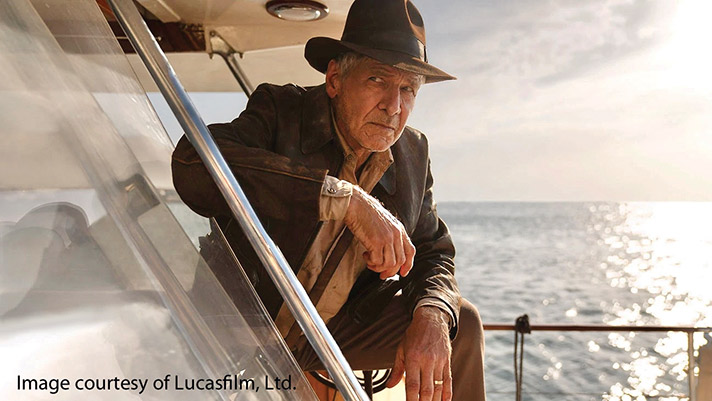The Unfettered Critic – August 2023
Forty-two.
Yes, it’s the ultimate answer to life, the universe and everything. But more importantly, it’s the number of years since we first met Indiana Jones—archaeologist/professor/badass, with a bullwhip at his side and a well-worn fedora on his head.
Over the years, we’ve watched him battle his way through hostile natives, fascistic militia, voodoo priests, soviet agents, alien beings, and simple wear and tear. Now Indy is dealing with the so-called “Dial of Destiny.” How does he manage to get out of bed each day, knowing what he might have to face?
We guess he’s still living by his perennial mantra: “I’m making this up as I go.”
His latest adventure is a delight for those of us who fell in love with the character in Raiders of the Lost Ark. Sure, we’ve heard grousing from folks who’d hoped to see sort of a redressed original, but face it, actor Harrison Ford turns eighty-one this year. That’s not to say he’s too old for the part—he is the part, for crying out loud. The action sequences run a little longer than they used to, but, hey, how fast are you running these days, let alone riding a galloping steed through Manhattan’s subway tunnels?
“If adventure has a name,” the franchise’s publicity once trumpeted, “it must be Indiana Jones!” But if you want more specific categorization, you’re going to need the Dewey Decimal System, because we see Indy’s adventures as literature. Although Indy once stated, “If you want to be a good archeologist, you gotta get out of the library,” we’re convinced that his exploits definitely belong there.
Raiders’ filmmakers were inspired by glorious film serials of old, which we liken to graphic novels: longform, illustrated tales generally intended for a more mature audience than kids’ comics.
The second movie—Indiana Jones and the Temple of Doom—moved into darker territory, borrowing from the subgenre of “horror comics,” such as “Tales from the Crypt.” The scene where the bad guy pulls a beating heart out of a man’s chest earned the film one of Hollywood’s first PG-13 ratings.
By the time Indiana Jones and the Last Crusade appeared, the producers had shifted to a different literary category: an adventure-filled memoir with heart (which, thankfully, remained where it was supposed to). You could shelve this in the library section containing your favorite rousing classic adventures, say Kipling’s Kim, or Stevenson’s Treasure Island.
The fourth film, Indiana Jones and the Kingdom of the Crystal Skull would be stored in the science fiction alcove—but not the section with genre masters like Asimov and Heinlein. More like the pulpy SF magazines of decades ago: Amazing Stories, Analog, and the like.
EDITOR’S NOTE: SPOILERS AHEAD!
And now, at long last, Indy has reached the grown-up shelves. Dial of Destiny marks the culmination of his life story. Characters from his past appear in the various “chapters,” filling him—and the audience—with memories. Indy feels old. The (spoiler alert) death of his son, and subsequent departure (spoiler again) of his heartbroken wife, has left him achingly lonely. A visit from his goddaughter Helena seems like a good diversion—until he learns that she wants to research an artifact that Indy and her father unearthed decades earlier. That way lies madness, Indy warns, but you’ve already surmised that’s not going to stop her, right?
Dial excavates opportunities for Indy to discover where his life doesn’t hurt, and to grab hold of it tightly. And, of course, to keep the fate of the whole danged world on track. As Helena tells our hero, “You’ve taken your chances. Made your mistakes. And now, a final triumph!”
If that’s not classic literature, we don’t know what is.

 Paula and Terry identify as writers, with an ever-increasing number of published works to support the supposition. They live a primarily pastoral life in the enchanted town of Jacksonville.
Paula and Terry identify as writers, with an ever-increasing number of published works to support the supposition. They live a primarily pastoral life in the enchanted town of Jacksonville.
Enjoyed your take on this!